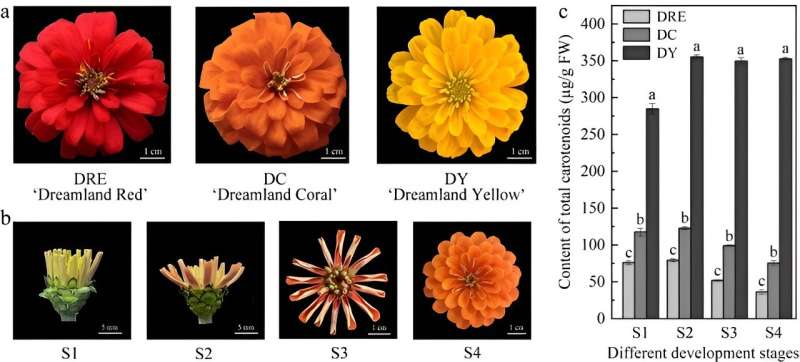This article has been reviewed according to Science X's editorial process and policies. Editors have highlighted the following attributes while ensuring the content's credibility:
fact-checked
trusted source
proofread
Regulation of carotenoid metabolism in Zinnia elegans by carotenoid cleavage dioxygenase

Zinnia elegans is an annual herbaceous ornamental flower widely cultivated in domestic and foreign gardens due to its diversity in flower types, color, and landscaping versatility. The Petal color of Zinnia elegans ranges widely from red to orange and yellow due to the different content of carotenoids and anthocyanins.
β-carotene is the main carotenoid in the petals. However, how the carotenoid cleavage dioxygenase genes, which are closely related to β-carotene degradation, participate in carotenoid metabolism in Zinnia elegans ray florets and regulate the molecular mechanism of petal coloration in different color cultivars of Zinnia elegans is still unclear and should be further investigated.
Ornamental Plant Research published a paper entitled "Carotenoid cleavage dioxygenase catalyzes carotenoid degradation and regulates carotenoid accumulation and petal coloration in Zinnia elegans" on 27 February 2024.
In this study, the total carotenoid content was determined in three Zinnia elegans cultivars: Zinnia elegans 'Dreamland Red' (DRE), Zinnia elegans 'Dreamland Coral' (DC), and Zinnia elegans 'Dreamland Yellow' (DY), at four developmental stages. The results showed that the total carotenoid content was highest in DY petals but lowest in DRE. Subsequently, three ZeCCDs (ZeCCD1, ZeCCD4-1, and ZeCCD4-2) were cloned from Zinnia elegans.
The bacterial pigment complementation system was used to characterize further the carotenoid cleavage ability of these genes, which showed different cleavage activities against four carotenoids (β-carotene, ε-carotene, zeaxanthin, lycopene) in E.coli cells, with ZeCCD1 having the strongest cleavage activity.
Meanwhile, the expression levels of ZeCCD1 and ZeCCD4-2 in the petals of different cultivars were significantly negatively correlated with the carotenoid content. In addition, the expression patterns and subcellular localization of ZeCCDs were analyzed.
The results showed that ZeCCD1 is localized in the cytoplasm, whereas ZeCCD4-1 and ZeCCD4-2 are localized in the chloroplast, indicating that ZeCCD4-2 plays a more important role in carotenoid cleavage and petal coloration in Zinnia elegans.
In conclusion, this study underscores the function of ZeCCDs in cleaving β-carotene, ε-carotene, zeaxanthin, and lycopene, as well as the relationship between the expression pattern and total carotenoid content in petals. It also highlights the important role of ZeCCD4-2 in carotenoid cleavage and lays a foundation for further research on the molecular mechanism of petal coloration and carotenoid metabolism of Zinnia elegans.
More information: Hongsheng Qing et al, Carotenoid cleavage dioxygenase catalyzes carotenoid degradation and regulates carotenoid accumulation and petal coloration in Zinnia elegans, Ornamental Plant Research (2024). DOI: 10.48130/opr-0024-0003
Provided by Chinese Academy of Sciences





















